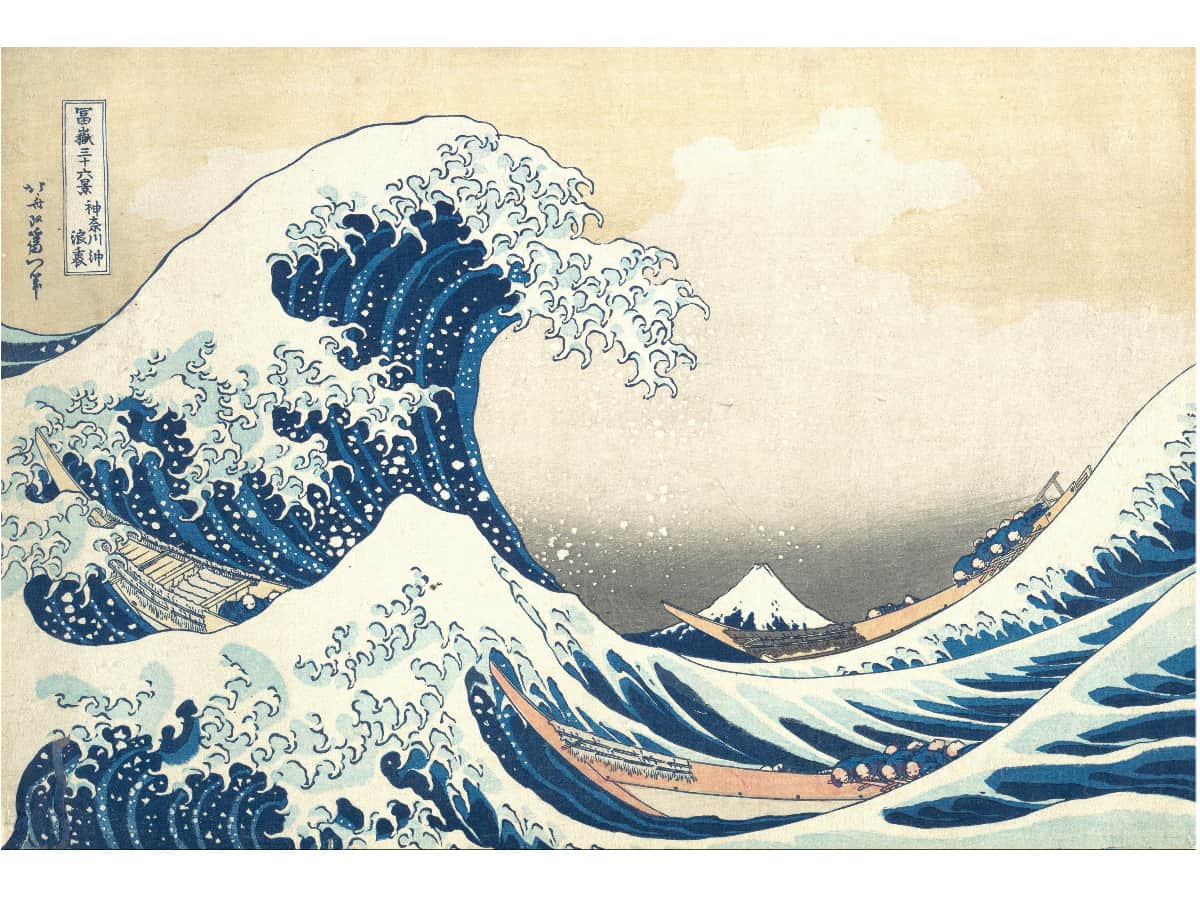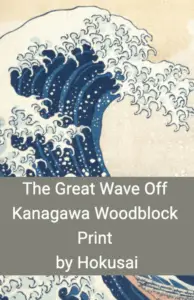Also Known as Under the Wave off Kanagawa by Hokusai
One of the most famous Japanese woodblock prints is the timeless woodblock by the Japanese artist Hokusai, known as The Great Wave Off Kanagawa or simply The Great Wave. The woodblock print continues to be an iconic and influential art piece.
The Japanese artist Hokusai produced The Great Wave Off Kanagawa woodblock print as part of his series called Thirty-six Views. The Great Wave off Kanagawa features a huge wave, a small Mount Fuji in the background, and three boats getting caught in the large wave. This print has remained so popular that it inspired music, poetry, and even a present-day emoji.
Table of Contents
- Japanese Artist Katsushika Hokusai
- The Great Wave Off Kanagawa Woodblock
- Other Artistic Inspirations From The Great Wave Off Kanagawa
- The Wave Emoji Of The Great Wave Off Kanagawa
- 10 Reasons Why We Love Hokusai’s “The Great Wave off Kanagawa
- Frequently Asked Questions
- Related Questions
Check out Our Art Series Short Stories – The Great Wave Off Kanagawa by Hokusai.
Japanese Artist Katsushika Hokusai
The Japanese artist Hokusai’s full name is Katsushika Hokusai, but he was simply known as Hokusai. He was born in 1790 in Edo, which is present-day Tokyo. Hokusai had a very long and varied career, but he produced most of his important work after he was 60. He lived to be 88 years old, so his artistic career spanned over seven decades.
Hokusai was a Japanese painter and printmaker. His best-known work is the Thirty-Six Views, which includes his iconic woodblock print known as The Great Wave off Kanagawa.
He created the Thirty-Six Views in response to a domestic travel boom and partly due to his obsession with Mount Fuji. This series of the Thiry-Six Views helped to ensure his fame, especially for his The Great Wave Off Kanagawa and Fine Wind, Clear Morning (Red Fuji) woodblock prints.
Through his work with the Thirty-Six Views, Hokusai became well-known not just in Japan but also overseas. As the historian and collector of Japanese art Richard Lane said when speaking of the print series of Thirty-Six Views:
“If there is one work that made Hokusai’s name, both in Japan and abroad, it must be this monumental print-series”.
Richard Lane
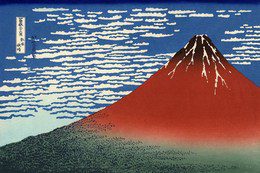
The Great Wave Off Kanagawa Woodblock
The Great Wave off Kanagawa, is also known as The Great Wave, The Wave, or Under the Wave off Kanagawa, is an iconic Japanese woodblock print. The Great Wave Off Kanagawa was published sometime between 1829 and 1833 or in what is known as Japan’s Edo period.
The Edo period or the Tokugawa period in Japan is from 1603 to 1868. This period in Japan’s history was known for its economic growth, strict social order, isolationism foreign policies, and stability It was an era where the arts and culture of Japan were able to flourish.
The Great Wave Wood Off Kanagawa woodblock print is the first print in Hokusai’s series called Thirty-Six Views. It is one of the most famous works of Japanese art in the world.
About the Wave, Boats and Mountains of The Great Wave Off Kanagawa.
In The Great Wave Off Kanagawa, you can see the top of Mount Fuji in the background as this enormous wave is towering over it. The wave is threatening three small fishing boats off the coastal town of Kanagawa, which is present-day Yokohama. Some have said that Hokusai was painting a tsunami wave, but it is more likely that it was a very large rogue wave.
The three boats are actually oshiokuri-bune, which are fast boats that were used to transport fish and other things. The fact that Hokasuai used the fast fishing boats of the time, gives additional emphasis on how big the wave was against these fast fishing boats.
There are eight rowers in each of the boats and then two more passengers at the front of the boat. This means there were a total of 30 people in these boats out there riding this large wave.
The sea is the dominant theme in The Great Wave Off Kanagawa woodblock print. At the exact moment in time that Hokasuai caught the big rogue wave it was framed perfectly with Mount Fuji in the center of the wave in the background. When using the boats as a reference we can approximate the size of the rogue wave to be 10 to 12 meters tall.
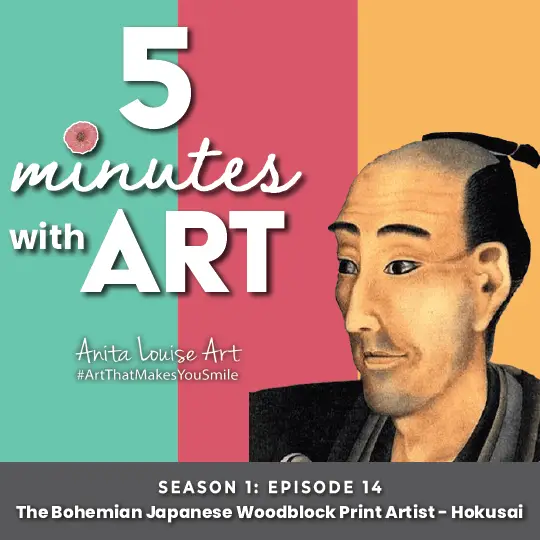
Listen To Our Podcast About The Bohemian Japanese Woodblock Print Artist – Hokusai
The Prussian Blue Ink and Woodblock Technique Used In The Great Wave Off Kanagawa
The Great Wave Off Kanagawa woodblock print uses the Prussian blue color, which is also known as Berlin blue, Parisian, Paris Blue, or Turnbull’s blue. It is a dark blue pigment. It was used in what is known as Aizuri-e, which is a Japanese term that refers to the Japanese woodblock prints that are printed almost entirely or predominantly in blue.
In speaking of The Great Wave Off Kanagawa the Metropolitan Museum of Art has said this about the uniqueness of the blues and inks used for The Great Wave Off Kanagawa art woodblock:
“At the time this print was produced, there was a demand for Berlin blue—popularly known as ‘Prussian blue’—imported from Europe. Scientific analysis has since revealed that both Prussian blue and traditional indigo were used in ‘the Great Wave’ to create subtle gradations in the coloring of this dramatic composition.“
Metropolitan Museum of Art
One of the most important aspects of the woodblock print artwork was that the image had to be mirrored when carving on the wood. This meant that the artist, when carving the woodblock, would have had to work in such a way to remember to mirror the images, especially if they were including any text to the art.
When actually carving the woodblock print in the traditional Japanese style, the artist would first draw the image they wanted to cut onto washi paper. Washi paper is a very thin yet durable type of Japanese paper made from the mulberry tree’s inner bark. The washi paper would be glued to the block of wood. Using the outline of what they have drawn on the washi paper as a guide, the artist would carve the design onto the woodblock.
Other Artistic Inspirations From The Great Wave Off Kanagawa
Two of the most notable inspirations that have come from Hokusai’s The Great Wave Off Kanagawa woodblock print is the musical work by Debussy called La Mer or The Sea and the literary work by Rilke, known as Der Berg or The Mountian.
La Mer (The Sea), A Musical Composition By Debussy.
The Sea, or Le Mer, is an orchestral composition by the French composer Claude Debussy. The composition was composed between 1903 and 1905, with its premiere in Paris in 1905.
The Hokusai woodblock of The Great Wave Off Kanagawa was said to inspire Debussy. A version of The Great Wave Off Kanagawa was on the cover of his 1905 Le Mer or The Sea musical composition score.
Der Berg (The Mountain) by Poet Rainer Maria Rilke
The Bohemian-Austrian poet and novelist were also inspired by Hokusai’s The Great Wave Off Kanagawa woodblock print. He is said to have been so taken by the woodblock print that he wrote a poem for it called Der Berg or The Mountain.
As Hokusai’s woodblock print The Great Wave Off Kanagawa had inspired both a composer (Debussy) and the writer (Rilke), this helped ensure that the woodblock print would remain an iconic Japanese woodblock print of the art world.
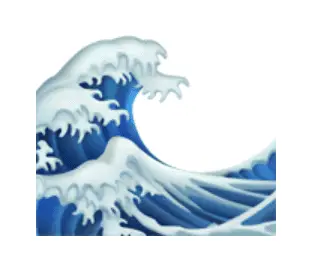
The Wave Emoji Of The Great Wave Off Kanagawa
The Great Wave Off Kanagawa is so popular and so well known that even today it has its own emoji. The emoji is the wave approved as Unicode 6.0 and added as an emoji in 2015.
The Wave Emoji is also known as the beach, ocean, sea, and waves. Apple, Google, Microsoft, Samsung, WhatsApp, Twitter, Facebook, JoyPixels, OPenMoji, Emojidex, Messenger, LG, HTC, Mozilla, SoftBank, Docomo, and Au by KDDI all have some version of the Wave. But the Apple emoji, known as the wave, resembles the Japanese Artist Hokusai’s The Great Wave Off Kanagawa woodblock print the closest.
The Great Wave Off Kanagawa woodblock print is an iconic Japanese artwork that has inspired many artists. It is fair to say that The Great Wave Off Kanagawa woodblock print is the most popular Japanese woodblock print ever created.
10 Reasons Why We Love Hokusai’s “The Great Wave off Kanagawa
We are deeply fascinated by the iconic masterpiece of Katsushika Hokusai, ‘The Great Wave off Kanagawa’. Its timeless allure and profound artistic expression captivate us, and here are ten reasons why this work holds a special place in our hearts.
1. Brilliant Composition The first thing that strikes you about “The Great Wave off Kanagawa” is its stunning composition. Hokusai masterfully balances the imposing wave with the distant Mount Fuji, creating a dynamic yet harmonious scene. The curve of the wave and the mountain’s stoic presence play off each other, drawing the eye in a mesmerizing dance.
2. Exemplary Woodblock Print Hokusai’s print is a prime example of ‘ukiyo-e’, a traditional Japanese woodblock printing technique. This art form, especially in the hands of a master like Hokusai, produces works with crisp lines and vibrant colors that have stood the test of time.
3. Captivating Movement of the Wave: The movement of the wave in this artwork is almost palpable. Hokusai captures the sea’s raw power and fluid motion in a way that feels both threatening and awe-inspiring. It’s a testament to his skill in portraying the natural world.
4. Symbolism of Power and Resilience The wave, often interpreted as a symbol of life’s challenges, contrasts with the tranquil and unyielding Mount Fuji in the background. This interplay represents the balance between chaos and stability, a theme that resonates with many.
5. Influence on Western Art Hokusai’s “Great Wave” significantly impacted Western art, influencing the Impressionist and Post-Impressionist movements. Artists like Van Gogh and Monet drew inspiration from its bold use of color and form.
6. Timeless Appeal Despite being created in the early 19th century, the artwork is timeless. Its themes and aesthetic appeal transcend cultural and temporal boundaries, making it relevant today.
7. Mastery of Color and Detail The use of Prussian blue, a then-recently introduced pigment from Europe, showcases Hokusai’s innovative approach to color. The intricate details of the wave and the distant boats highlight his meticulous craftsmanship.
8. Emotional Impact There’s an undeniable emotional pull to “The Great Wave off Kanagawa.” It captures a moment of beauty and terror, evoking feelings of awe and respect for nature’s power.
9. Pop Culture Icon The image has become an icon in popular culture, its influence seen in everything from fashion to film. It’s a testament to its enduring appeal and universal recognition.
10. Educational Value Finally, “The Great Wave” provides insight into Edo-period Japan, the ukiyo-e art form, and Hokusai’s legacy. It’s a piece that continues to inspire and educate, bridging history and art in a captivating way.
This iconic work by Hokusai is more than just a piece of art; it’s a cultural phenomenon that continues to inspire and captivate audiences around the world.
Anita Louise Art is dedicated to art education, great artists, and inspiring others to find and create their art. We love art that uplifts and inspires. #ArtToMakeYouSmile! #ArtToMakeYouHappy!
If you are interested in seeing any of my art, you can find out more by clicking here. If you are interested in what inspires me and my paintings, you can discover more by clicking here.
We have a free newsletter and would love you to be part of our community; you can subscribe to the newsletter by clicking here. I would be happy to talk to you if you have any questions. You can reach me, Anita, by clicking here.
Subscribe to our Anita Louise Art YouTube Channel filled with great videos and information by clicking here.
Join us for our podcast “5 Minutes With Art.” Spend 5 minutes a week with us to discover and learn about great art and artists. You can find out more about our podcast by clicking here.
Frequently Asked Questions
What is “The Great Wave Off Kanagawa” by Hokusai?
“The Great Wave Off Kanagawa” is a famous woodblock print created by Japanese artist Hokusai around 1831. It is part of his series “Thirty-six Views” and is considered one of the most iconic and influential art pieces in Japanese history.
Why is it also known as “Under the Wave off Kanagawa”?
The print is also known as “Under the Wave off Kanagawa” because it depicts three boats struggling beneath a towering wave near the coastal region of Kanagawa, with Mount Fuji in the background.
What inspired Hokusai to create this woodblock print?
Hokusai drew inspiration from the coastal landscapes of Japan, particularly the views of Mount Fuji from the Sagami Bay. The powerful and dynamic portrayal of the wave captures the essence of the unpredictable nature of the sea.
What is the significance of Mount Fuji in “The Great Wave Off Kanagawa”?
Mount Fuji represents a symbol of Japanese identity and enduring strength. Its inclusion in the background adds a serene contrast to the chaotic and forceful wave in the foreground.
How did Hokusai achieve the intricate details in the woodblock print?
Hokusai used traditional Japanese woodblock printing techniques, carving the design onto wooden blocks and applying ink to create multiple impressions. This meticulous process allowed him to achieve the fine details and intricate lines seen in the final print.
What is the cultural impact of “The Great Wave Off Kanagawa”?
The print has had a profound influence on global art and culture, inspiring various forms of artistic expression, from music and poetry to contemporary design. Its wave motif has become an enduring symbol in popular culture.
Are there any hidden meanings or interpretations associated with the print?
While interpretations may vary, some view the print as a metaphor for the transient nature of life, with the powerful wave symbolizing the challenges and uncertainties individuals face.
How did “The Great Wave Off Kanagawa” influence Western art movements?
The print had a significant impact on European artists during the late 19th century, influencing the development of Japonism. Artists such as Vincent van Gogh and Claude Monet were inspired by the unique aesthetics and perspectives found in Japanese woodblock prints.
Has “The Great Wave Off Kanagawa” been reproduced or referenced in modern times?
Yes, the print continues to be widely reproduced and referenced in various forms of contemporary art, design, and pop culture. Its distinctive wave design has even been adapted into a popular emoji.
Where can one view an original copy of “The Great Wave Off Kanagawa”?
Original copies of “The Great Wave Off Kanagawa” are housed in museums and private collections worldwide. Notable institutions such as the British Museum in London and the Tokyo National Museum in Japan may have copies on display for public viewing.
Related Questions
Who Was the Mexican Artist Frida Kahlo (1907-1954)?
Frida Kahlo is one of Mexico’s most well-known and premier artists. She suffered from polio and was in a bus accident that left her with a lot of pain and suffering. Kahlo married the famous Mexican artist Diego Rivera. She is well known for her self-portraits that depict pain and suffering, but her artwork is also filled with passion and bright, bold vibrant colors. Her art is a personal statement of her life, painting, and culture of Mexico.
To discover more about Frida Kahlo, you can read our blog on Who Was the Mexican Artist Frida Kahlo (1907-1954)? by clicking here.
Who is the Swedish Artist Hilma af Klint (1862-1944)?
Hilma af Klint was a Swedish woman artist who painted trailblazing modern artwork for her time. She was a revolutionary, creative figure who kept her art and paintings secret for many years. Despite her unique works of art and legacy, she left us, it has only been during the last 40 years that she has started to gain worldwide acclaim.
You can discover more about Hilma af Klint by reading our blog Who is the Swedish Artist Hilma af Klint (1862-1944)? by clicking here.

